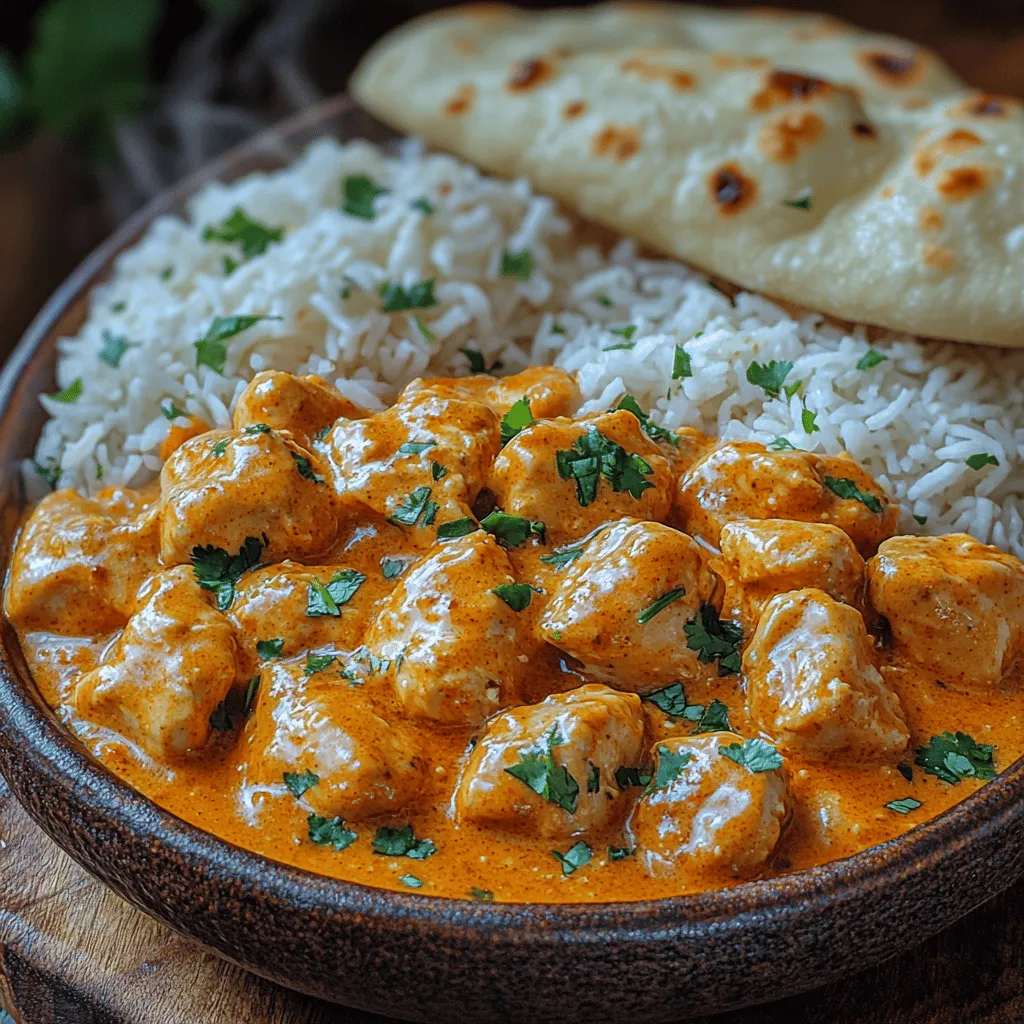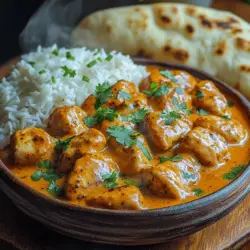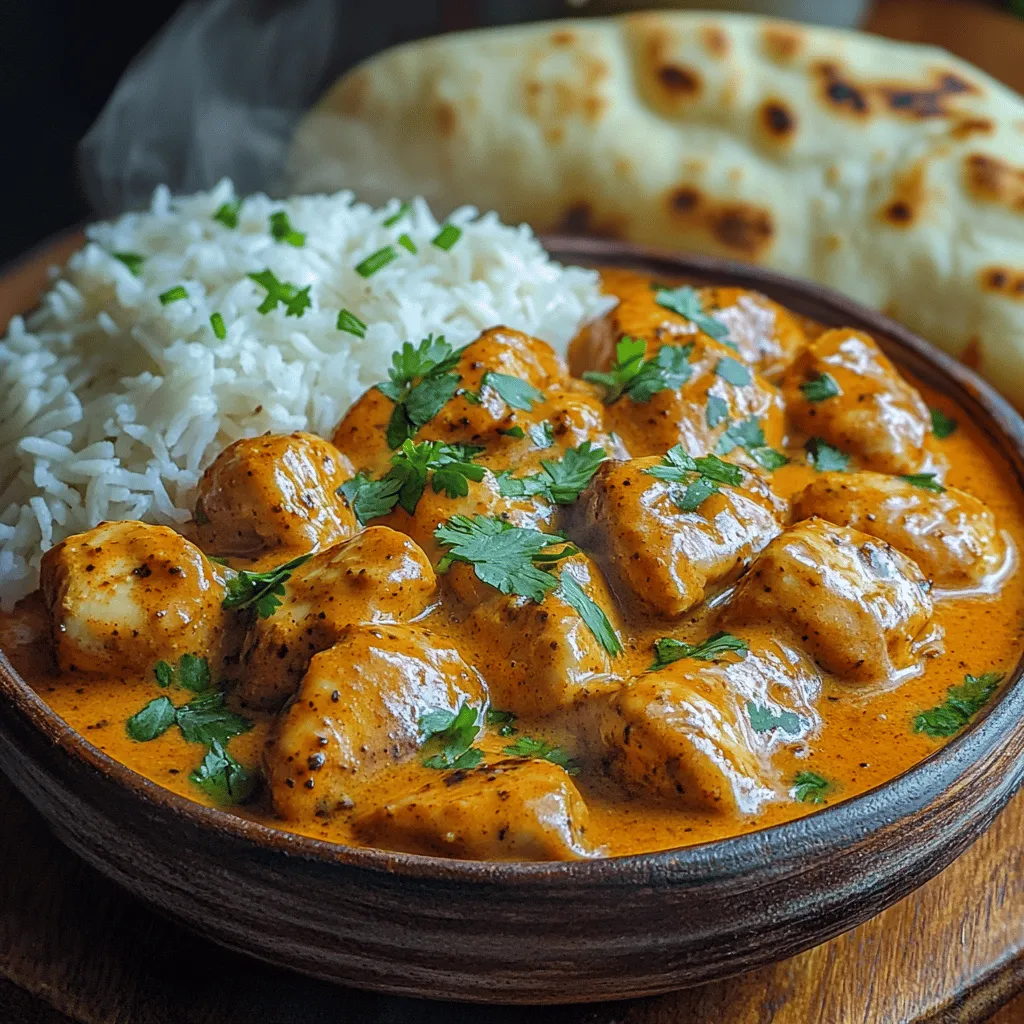Introduction
Discover the rich and aromatic world of Indian cuisine with this Butter Chicken Bliss recipe. Known for its creamy tomato-based sauce and tender chicken, this dish offers an explosion of flavors that will transport your taste buds straight to the heart of India. Butter chicken, or “Murgh Makhani,” is a beloved dish that has gained international acclaim, renowned for its luscious texture and complex flavors. Whether you’re a seasoned chef or a kitchen novice, this recipe is designed for simplicity and satisfaction, making it an ideal choice for family dinners or special occasions. In this article, we will delve into the ingredients, step-by-step preparation, and some fascinating insights into the origins and variations of Butter Chicken.
Understanding Butter Chicken
Exploring the Origins of Butter Chicken
Butter chicken has an intriguing history that dates back to the 1940s in Delhi, India. The dish was purportedly created by the chefs at the Moti Mahal restaurant, who were looking for a way to use leftover chicken from tandoori cooking. They devised a rich, buttery sauce made with tomatoes, cream, and spices to accompany the chicken, resulting in a dish that was both flavorful and indulgent. This innovative approach to cooking was not only a clever use of resources but also a reflection of the evolving culinary landscape in India during that period.
Culturally, Butter Chicken holds a significant place in Indian cuisine. It represents the fusion of traditional Indian flavors with the influence of Mughlai cooking, characterized by rich gravies and the use of cream. The dish has since become a staple in Indian households and restaurants worldwide, often symbolizing the warmth and hospitality associated with Indian dining. The creamy sauce, combined with the tender chicken, creates a dish that is both comforting and celebratory, making it a favorite for gatherings and special occasions.
The Evolution of Butter Chicken
While Butter Chicken has its roots in a traditional recipe, it has undergone various adaptations over the years. The basic components of the dish remain the same—chicken, tomatoes, cream, and spices—but the methods and additional ingredients can vary widely. In traditional preparations, the chicken is marinated in yogurt and spices before being grilled in a tandoor, giving it a distinctive smoky flavor. However, modern adaptations often involve baking or pan-searing the chicken, making it more accessible for home cooks.
Moreover, Butter Chicken can differ significantly across different regions of India. For instance, in Punjab, where the dish originated, the recipe might include fenugreek leaves for added flavor. In contrast, some urban variations may incorporate ingredients like cashew nuts or even coconut milk to achieve a unique twist on the classic. This versatility not only highlights the adaptability of Butter Chicken but also showcases the diverse culinary traditions of India.
Ingredients Breakdown
Essential Ingredients for Butter Chicken
To create the authentic Butter Chicken experience, it is crucial to select the right ingredients. The key components are relatively simple yet impactful:
1. Chicken: Boneless chicken thighs or breasts are the primary protein in this dish. Thighs are often preferred for their higher fat content, which yields a juicier and more flavorful result. However, chicken breasts can also work well if you prefer a leaner option.
2. Tomatoes: Fresh tomatoes or canned tomato puree forms the base of the sauce. Their natural acidity balances the rich creaminess of the dish.
3. Cream: Heavy cream is essential for achieving the velvety texture that Butter Chicken is known for. It adds richness and helps mellow the spices.
4. Yogurt: Used in the marinade, yogurt tenderizes the chicken while adding a tangy flavor.
5. Spices: A blend of traditional Indian spices—cumin, coriander, garam masala, turmeric, and chili powder—creates the aromatic foundation of the dish.
6. Aromatics: Onions, garlic, and ginger are sautéed to build flavor in the sauce.
Each of these ingredients plays a vital role in developing the overall flavor profile of Butter Chicken. The balance of spices, the creaminess of the sauce, and the tenderness of the chicken come together to create a dish that is both comforting and exciting.
Choosing the Right Chicken
When it comes to selecting chicken for your Butter Chicken recipe, the choice between boneless chicken thighs and breasts can significantly impact the final dish. Boneless chicken thighs are often recommended due to their higher fat content, which contributes to a moist and flavorful result. The thighs also benefit from marination, as the yogurt and spices penetrate the meat, enhancing its tenderness and flavor.
On the other hand, chicken breasts are a leaner option that can still deliver excellent results when cooked properly. If you opt for breasts, be mindful of cooking times, as they can dry out if overcooked. Regardless of the cut you choose, marinating the chicken is crucial. A simple marinade of yogurt and spices will not only infuse flavor but also ensure that the chicken remains juicy throughout the cooking process.
Spices that Make a Difference
The heart of Butter Chicken lies in its spices. Understanding the role of each spice can elevate your dish to new heights. Here are the essential spices you’ll need:
– Cumin: This warm, earthy spice adds depth to the dish. It is often used in both whole and ground form. Toasting cumin seeds before adding them to the dish enhances their flavor.
– Coriander: Ground coriander has a citrusy note that complements the richness of the sauce. It balances the heat from other spices and adds complexity.
– Garam Masala: A quintessential Indian spice blend, garam masala is usually added towards the end of cooking to retain its aromatic qualities. It typically includes spices like cardamom, cinnamon, and cloves.
– Turmeric: This vibrant yellow spice not only adds color but also a subtle warmth. Turmeric is known for its anti-inflammatory properties and is a staple in many Indian dishes.
– Chili Powder: Depending on your spice tolerance, chili powder adds the necessary heat to the dish. Adjust the quantity to suit your taste.
Sourcing authentic Indian spices is key to capturing the true essence of Butter Chicken. While many supermarkets carry a selection of spices, visiting an Indian grocery store can provide access to fresher, higher-quality options. Look for whole spices that you can grind yourself for the best flavor.
Step-by-Step Cooking Instructions
Preparing the Aromatics
The first step in crafting your Butter Chicken is preparing the aromatics. Sautéing onions, garlic, and ginger creates a fragrant base for the sauce. Begin by finely chopping one large onion and setting it aside.
Heat a tablespoon of oil or ghee in a large skillet over medium heat. Once the oil is hot, add the chopped onions and sauté them until they become translucent and golden brown. This process can take about 8-10 minutes. The key to achieving the perfect sauté is to allow the onions to caramelize gently, developing their natural sweetness without burning.
Next, add minced garlic and ginger to the skillet. The combination of these aromatics will infuse the oil with a wonderful fragrance. Sauté the garlic and ginger for about 1-2 minutes, stirring frequently to prevent burning. Once they become fragrant, it’s time to move on to the next step.
Toasting the Spices
Toasting the spices is a vital step in enhancing their flavors. Once the aromatics are ready, add the ground spices—cumin, coriander, turmeric, and chili powder—to the skillet. Stir the spices into the onion mixture, letting them toast for about 1-2 minutes. This process releases the essential oils in the spices, intensifying their flavors and adding depth to your sauce.
As the spices toast, you might notice an aromatic cloud filling your kitchen, a sign that your Butter Chicken is well on its way to perfection. Keep stirring to ensure the spices do not burn; you want them to bloom and create a fragrant base for the sauce rather than become bitter.
Next, add in the tomato puree or chopped fresh tomatoes. Stir well to combine with the spiced onion mixture. As the tomatoes cook down, they will break apart and meld with the spices, creating the rich, flavorful sauce that defines Butter Chicken. Allow the mixture to simmer for about 10-15 minutes, stirring occasionally, until it thickens and deepens in color.
With the sauce prepared, you’re now ready to move on to the key elements that will transform this mixture into Butter Chicken bliss. Stay tuned for the next steps where the marinated chicken will be added, and the creamy finish will bring everything together.
In this part of the recipe, we have laid the groundwork for a dish that is not only delicious but rich in history and flavor. The next section will guide you through the remaining steps, ensuring that your Butter Chicken is a delightful experience for you and anyone fortunate enough to share your table.

Toasting spices before adding them to your dishes not only enhances flavor but also elevates the overall cooking experience. This technique releases the essential oils within the spices, resulting in a more robust and aromatic profile. For our Butter Chicken Bliss, toasting spices such as cumin, coriander, and garam masala in a dry skillet for a few moments before mixing them with the other ingredients will significantly enrich the dish. This step is crucial as it transforms the spices from their raw state into a fragrant blend that can truly make your sauce sing.
Cooking the Chicken
When it comes to cooking the chicken for your Butter Chicken, timing and technique are everything. The ideal way to achieve a beautifully browned chicken is by searing it in batches. Start by ensuring your pan or skillet is hot before adding the chicken pieces. This high heat will create an instant sear, locking in moisture and flavor. Sauté the chicken in a little oil or ghee, avoiding overcrowding the pan to ensure an even cook. If you add too many pieces at once, the temperature drops, and you end up with steamed chicken instead of the desired golden exterior.
It’s essential to cook the chicken until it reaches an internal temperature of 165°F (75°C). However, you want to be careful not to overcook it, as this can lead to dry, chewy meat. An excellent way to check for doneness is to use a meat thermometer, but if you don’t have one handy, look for juices that run clear when pierced. Once cooked, set aside the chicken while you work on creating the sauce.
Creating the Sauce
The magic of Butter Chicken lies in the sauce, which is where the flavors meld together beautifully. Start by blending your tomatoes until smooth; this forms the base of the sauce. When cooking the tomatoes, it’s vital to do so over medium heat, allowing them to simmer and break down, which helps concentrate their sweetness. Add your toasted spices gradually, stirring to combine and releasing their delightful aromas.
As you combine the spices with the tomatoes, be mindful of the seasoning. Taste as you go—this is the key to achieving a well-balanced dish. Depending on your preference, you might want to add a pinch of sugar to cut through the acidity of the tomatoes or adjust the salt to enhance the overall flavor profile.
Once you achieve a harmonious blend of flavors, it’s time to introduce the chicken back into the pot. Allow it to simmer in the sauce for a few minutes, letting the flavors meld together before moving on to the finishing touches.
Finishing Touches with Cream
Heavy cream is the star player when it comes to creating the rich, velvety texture that Butter Chicken is known for. To achieve the perfect creamy sauce, you’ll want to add the cream slowly and stir continuously while it simmers. This method helps incorporate the cream without curdling and ensures a smooth, luscious finish.
To further enhance the creaminess, consider blending in a bit of butter at the end. This not only enriches the flavor but also adds a glossy finish to your sauce. If you’re seeking a lighter version, you can substitute part of the heavy cream with Greek yogurt or coconut milk for a dairy-free alternative, keeping in mind that this may alter the flavor slightly.
Serving Suggestions
Butter Chicken is traditionally served with basmati rice or naan, both of which complement the dish beautifully. Basmati rice, known for its fragrant aroma and fluffy texture, acts as the perfect canvas for soaking up the luscious sauce. When cooking the rice, ensure that you rinse it thoroughly to remove excess starch—this results in perfectly separated grains.
When it comes to naan, selecting the right type can significantly enhance your dining experience. Consider serving with garlic naan or butter naan, which adds an extra layer of flavor that pairs perfectly with the creamy sauce. You can either purchase naan from a local store or make your own for a more authentic experience.
Garnishes that Enhance Flavor
To elevate your Butter Chicken further, consider adding garnishes that not only enhance the presentation but also add a burst of freshness. Fresh cilantro is a classic garnish for Butter Chicken, providing a vibrant green contrast and a hint of herbal aroma that complements the spices beautifully.
Other recommended garnishes include a sprinkle of crushed red pepper for those who appreciate a bit of heat, or a drizzle of lemon juice to add brightness to the dish. Sliced green chilies can also be an excellent addition for those who enjoy an extra kick.
Nutritional Information
Understanding the nutritional value of your meal is essential, especially when catering to dietary needs. A typical serving of Butter Chicken contains approximately 500-600 calories, with the breakdown generally including around 30-35 grams of protein, 40-50 grams of fat, and minimal carbohydrates.
For those looking to make healthier choices, there are several alternatives you can consider. For instance, using skinless chicken breast instead of thighs can reduce the fat content, while substituting heavy cream with lighter options like evaporated milk or coconut cream can also lower calories while maintaining flavor.
Conclusion
Butter Chicken Bliss is more than just a recipe; it’s a celebration of flavors that embodies the essence of Indian cuisine. With its straightforward preparation and rich taste, this dish not only satisfies the palate but also brings people together around the dining table. Whether you’re enjoying it as a comforting weeknight meal or serving it at a festive gathering, Butter Chicken is sure to impress. Embrace the warmth and richness of this dish, and let it inspire you to explore more culinary delights from around the world.
Indulge in this delightful recipe, and share it with family and friends. The experience of preparing Butter Chicken is as rewarding as enjoying it—each step is an opportunity to learn and savor the intricate flavors of Indian cooking. With every bite, you’ll find comfort in the knowledge that you’ve created a dish that not only nourishes the body but also warms the heart.

